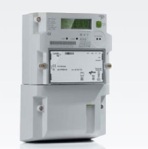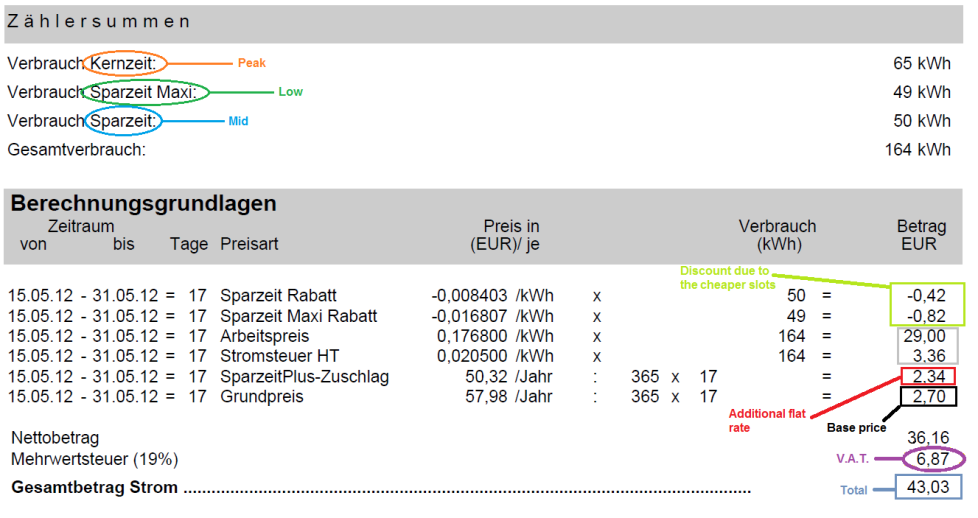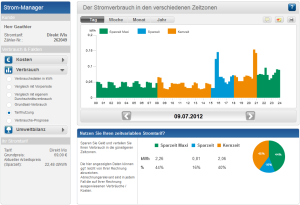Smart advices for smart meter users
January 3, 2013 1 Comment
Some stats
As explained in a previous post, I have acquired a Smart Meter and promised to keep you informed. Now that 2013 begins, it’s time to take a closer look at the stats of my electricity consumption available through my smart meter.
I spare you the explanation how to import data in Excel and how to perform the calculations. The website interface proposed by my utility Mainova is not really user friendly and a lot of manual handling is necessary to import data for each day individually.
The previous figure shows my average daily consumption curve. Quite a typical one for households without electric heating (my family enjoys district heating). It also shows that Mainova’s tariff policy makes sense: lower tariff during low load and higher during peak load. The tariff structure to incite clients to pay attention to their load curve is well defined.
Still bad news
Now, as explained in a previous post, Mainova’s rates for the use of a smart meter are not appropriate for consumers (economically speaking). The Time of Use (ToU) tariff does not compensate the rental fee for the smart meter. For the 8 months since the smart meter is installed, I have effectively paid 3% more than the standard tariff without smart meter.
Modifying behaviour to shift consumption from peak to low hours could reduce the losses to 1%, but no wins. So I stay on my position not to bother my family with drastic changes (for instance, to eat before 6 PM or after 9 PM to avoid peak hours), unless Mainova modifies its tariff policy.
What utilities might change
I believe in smart meters. They are useful. But I think consumers should have the right to get access to this technology at a more decent price. Let’s recommend a new tariff structure that can foster the installation of smart meters amongst Mainova’s clients:
| Current prices (€) | Proposed prices (€) | |
| Peak (orange slot) | 0.2348 | Middle + 20% = 0.2697 |
| Middle (blue slot) | 0.2248 | Unchanged = 0.2248 |
| Low (green slot) | 0.2148 | Middle – 30% = 0.1574 |
In this case, the yearly bill is the same with or without smart meters (in my case). But with drastic behaviour change, my family could spare 13%, which is quite interesting. With limited and less annoying change, few percents of savings can be easily achieved. This is clearly a win-win situation:
- If consumption habits remain the same, the client pays the same price (with or without smart meter).
- If the client pays attention to his load curve and shifts some loads from peak to low hours, he pays less and utility’s peak load is accordingly reduced.
- If the client consumes less (for instance by investing in energy efficiency devices), he pays less and utility’s production is accordingly reduced (like for any tariff structure).
What to do now?
@Mainova’s customers: do not accept a smart meter unless you are ready to pay more or to drastically change your habits.
@Mainova: please, improve your tariff structure to share the wins of smart meters deployment. As explained previously, utilities benefits are known: smart meters help you to cope with deregulation and market-driven pricing, to adapt to higher renewable energy penetration rate, real-time load data, etc.
@All of us: be critical when talking about smart grid, look at the pictures and make decision based on information, not on advertisement.
Our prediction
Customers will be more and more reluctant to accept a smart meter in their home, unless utilities communicate on their smart meters strategy and objectives, share the benefits with their clients, guarantee privacy and take into account stakeholders interests.
Flavien Port / Gauthier Dupont
Related articles
- Will smart meters benefit consumers? By Gill Owen (eco-business.com)
- Japan to roll out smart meters in the next decade (eco-business.com)






